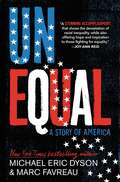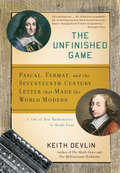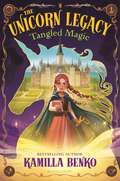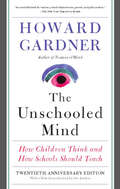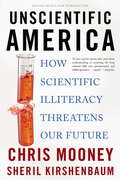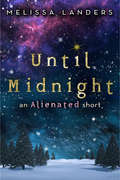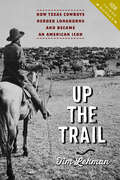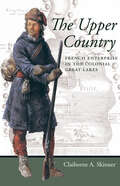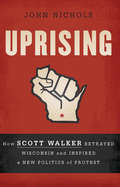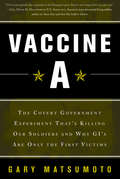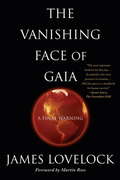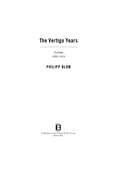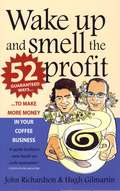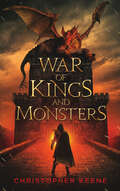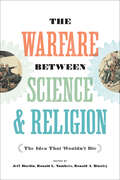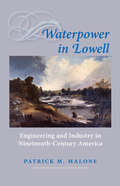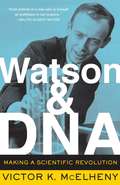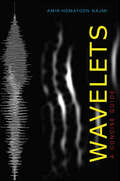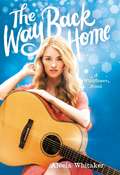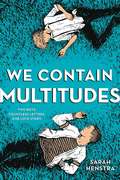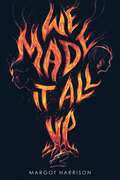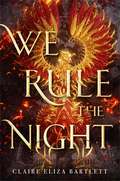- Table View
- List View
Unequal: A Story of America
by Michael Eric Dyson Marc FavreauFinalist for the YALSA Excellence in Nonfiction for Young Adults Award New York Times bestselling author Michael Eric Dyson and critically acclaimed author Marc Favreau show how racial inequality permeates every facet of American society, through the lens of those pushing for meaningful change The true story of racial inequality—and resistance to it—is the prologue to our present. You can see it in where we live, where we go to school, where we work, in our laws, and in our leadership. Unequal presents a gripping account of the struggles that shaped America and the insidiousness of racism, and demonstrates how inequality persists. As readers meet some of the many African American people who dared to fight for a more equal future, they will also discover a framework for addressing racial injustice in their own lives.
The Unfinished Game: Pascal, Fermat, and the Seventeenth-Century Letter that Made the World Modern (Basic Ideas Ser.)
by Keith DevlinIn the early seventeenth century, the outcome of something as simple as a dice roll was consigned to the realm of unknowable chance. Mathematicians largely agreed that it was impossible to predict the probability of an occurrence. Then, in 1654, Blaise Pascal wrote to Pierre de Fermat explaining that he had discovered how to calculate risk. The two collaborated to develop what is now known as probability theory-a concept that allows us to think rationally about decisions and events.In The Unfinished Game, Keith Devlin masterfully chronicles Pascal and Fermat's mathematical breakthrough, connecting a centuries-old discovery with its remarkable impact on the modern world.
The Unicorn Legacy: Tangled Magic
by Kamilla Benko"A sparkling page-turner full of surprising twists, clever girls, and magical wonders!" -Tui Sutherland, #1 New York Times bestselling author of the Wings of Fire seriesFrom the creator of The Unicorn Quest series, a wondrous new series set in the magical land of Arden, full of unicorns and mystery!Magic pulses bright in Arden, a world where humans who craft magic have been at war and separated for hundreds of years. Now a new era has dawned, the unicorns have returned, and the prime minister has decreed that apprentices from all four guilds will learn in the newly formed Unicorn Academy. But peace is tenuous: As rumors spread of dark magic and of unicorns disappearing, twelve-year-old apprentice Olivia Hayes is caught between her joy at newfound magical abilities at the academy and proving to everyone that her older sister, Laurel, is NOT a unicorn poacher. She and her friends must untangle the truth and the secrets of the past to spin a stronger future-or else the unicorns of Arden may be lost forever. This sweeping middle grade fantasy is about friendship, choice, and the ties that truly matter.
The Unschooled Mind: How Children Think and How Schools Should Teach
by Howard GardnerMerging cognitive science with educational agenda, Gardner makes an eloquent case for restructuring our schools by showing just how ill-suited our minds and natural patterns of learning are to the prevailing modes of education. This reissue includes a new introduction by the author.
Unscientific America: How Scientific Illiteracy Threatens our Future
by Chris Mooney Sheril KirshenbaumClimate change, the energy crisis, nuclear proliferation-many of the most urgent problems of the twenty-first century require scientific solutions, yet America is paying less and less attention to scientists. For every five hours of cable news, less than one minute is devoted to science, and the number of newspapers with science sections has shrunk from ninety-five to thirty-three in the last twenty years. In Unscientific America, journalist and best-selling author Chris Mooney and scientist Sheril Kirshenbaum explain this dangerous state of affairs, proposing a broad array of initiatives that could reverse the current trend.An impassioned call to arms, Unscientific America exhorts Americans to reintegrate science into public discourse-before it is too late.
Until Midnight: An Alienated short (Alienated)
by Melissa LandersDon't miss the free romantic story that connects Alienated and Invaded! Cara and Aelyx only have one day to spend together before he returns to earth and she travels to Aelyx's home planet, L'eihr. Homesick and worried about the upcoming year apart, Cara is desperate to make these final hours count. Worst of all, Cara is missing Christmas, stuck on board an alien spaceship. When Aelyx learns that Cara is forgoing her favorite holiday, he tries to recreate Christmas in space by researching traditional earth customs...but a few things get lost in translation.Includes bonus chapters from Alienated and a sneak peek at Invaded.
Up the Trail: How Texas Cowboys Herded Longhorns and Became an American Icon (How Things Worked)
by Tim LehmanCattle drives were the largest, longest, and ultimately the last of the great forced animal migrations in human history. Spilling out of Texas, they spread longhorns, cowboys, and the culture that roped the two together throughout the American West. In cities like Abilene, Dodge City, and Wichita, buyers paid off ranchers, ranchers paid off wranglers, and railroad lines took the cattle east to the packing plants of St. Louis and Chicago. The cattle drives of our imagination are filled with colorful cowboys prodding and coaxing a line of bellowing animals along a dusty path through the wilderness. These sturdy cowhands always triumph over stampedes, swollen rivers, and bloodthirsty Indians to deliver their mighty-horned companions to market;¢;‚¬;€?but Tim Lehman;€™s Up the Trail reveals that the gritty reality was vastly different. Far from being rugged individualists, the actual cow herders were itinerant laborers;¢;‚¬;€?a proletariat on horseback who connected cattle from the remote prairies of Texas with the nation;€™s industrial slaughterhouses. Lehman demystifies the cowboy life by describing the origins of the cattle drive and the extensive planning, complicated logistics, great skill, and good luck essential to getting the cows to market. He reveals how drives figured into the larger story of postwar economic development and traces the complex effects the cattle business had on the environment. He also explores how the premodern cowboy became a national hero who personified the manly virtues of rugged individualism and personal independence. Grounded in primary sources, this absorbing book takes advantage of recent scholarship on labor, race, gender, and the environment. The lively narrative will appeal to students of Texas and western history as well as anyone interested in cowboy culture.
The Upper Country: French Enterprise in the Colonial Great Lakes (Regional Perspectives on Early America)
by Claiborne A. SkinnerThe Upper Country melds myth and conventional history to provide a memorable tale of French designs in the middle of what became the United States. Putting the reader on the battlefields, at the trading posts, and on the rivers with voyageurs and their allies from the Indian nations, Claiborne Skinner reveals the saintly missionaries and jolly fur traders of popular myth as agents of a hard-nosed, often ruthless, imperial endeavor. Skinner’s engaging narrative takes the reader through daily life at posts like Forts Saint Louis and Michilimakinac, illuminates the complexities of interracial marriage with the courtship of Michel Aco at Peoria, and explains how France's New World adventurism played a role in the outbreak of the Seven Years War and the beginning of the modern era.In this story, many of the traditional heroes and villains of American history take on surprising roles. The last Stuart kings of England seem shrewd and even human; George Washington makes his debut appearance on the stage of history by assassinating a French officer and plunging Europe into the first truly global war. From unthinkable hardship to dreams of fur trade profits, this fascinating exploration sheds new light on France and its imperial venture into the Great Lakes.
Uprising: How Scott Walker Betrayed Wisconsin and Inspired a New Politics of Protest
by John NicholsOn February 11, 2011, Wisconsin Governor Scott Walker announced he would strip collective bargaining rights from public employees and teachers. In response, people rose up in mass protest, and Wisconsin became a reference point for a renewal of labor militancy and radical politics. These protests elicited extensive national media coverage, and drew more attention from the general public than any American labor struggle in decades.John Nichols's Uprising traces the roots of this struggle-which has faced legislative disappointments, legal challenges, and dramatic electoral twists and turns-and in the process reveals how Scott Walker rose to national prominence and went on to become a frontrunner in the Republican race for the nomination in 2016. At a time when public services are under assault from corporate privatizers and billionaire political donors, the public repudiation of Walker's efforts (and the shadowy interests like the Koch Brothers behind them) has translated into a broader challenge to corporate America, Wall Street, the far Right, and its media echo chamber.
Vaccine A: The Covert Government Experiment That's Killing Our Soldiers--and Why GI's Are Only the First Victim
by Gary MatsumotoIn this provocative look at the US military from the Persian Gulf War through the 2003 invasion of Iraq, investigative journalist Gary Matsumoto contends that an anthrax vaccine dispensed by the Department of Defense was the cause of Gulf War Syndrome and the origins of a massive cover-up. Matsumoto calls it the worst friendly-fire incident in military history. A skillfully-woven narrative that serves as a warning about this man-made epidemic, Vaccine A is a much needed account of just what went wrong, and why.
The Vanishing Face of Gaia: A Final Warning
by James LovelockThe global temperature is rising, the ice caps are melting, and levels of pollution across the world have reached unprecedented heights. According to eminent scientist James Lovelock, in order to survive an assault from her dependents, the Earth is lurching ever closer to a permanent "hot state.” Within the next century, we will almost certainly be forced to give up many of the comforts of western living as supplies are threatened. Only the fittest-and the smartest-will survive.A reluctant jeremiad from one of the environmental movement's elder statesmen, The Vanishing Face of Gaia offers an essential wake-up call for the human race.
The Vertigo Years: Europe, 1900-1914
by Philipp BlomEurope, 1900-1914: a world adrift, a pulsating era of creativity and contradictions. The major topics of the day: terrorism, globalization, immigration, consumerism, the collapse of moral values, and the rivalry of superpowers. The twentieth century was not born in the trenches of the Somme or Passchendaele-but rather in the fifteen vertiginous years preceding World War I.In this short span of time, a new world order was emerging in ultimately tragic contradiction to the old. These were the years in which the political and personal repercussions of the Industrial Revolution were felt worldwide: Cities grew like never before as people fled the countryside and their traditional identities; science created new possibilities as well as nightmares; education changed the outlook of millions of people; mass-produced items transformed daily life; industrial laborers demanded a share of political power; and women sought to change their place in society-as well as the very fabric of sexual relations.From the tremendous hope for a new century embodied in the 1900 World's Fair in Paris to the shattering assassination of a Habsburg archduke in Sarajevo in 1914, historian Philipp Blom chronicles this extraordinary epoch year by year. Prime Ministers and peasants, anarchists and actresses, scientists and psychopaths intermingle on the stage of a new century in this portrait of an opulent, unstable age on the brink of disaster.Beautifully written and replete with deftly told anecdotes, The Vertigo Years brings the wonders, horrors, and fears of the early twentieth century vividly to life.
Wake Up and Smell the Profit: 52 guaranteed ways to make more money in your coffee business
by John Richardson Hugh GilmartinWitty, authoritative, comprehensive and fun, Wake Up and Smell the Profit is the ultimate guide to making more money in your coffee business.In this book you'll find the sharpest insights and the best ideas from two of the UK's top Coffee Business Gurus. Together 'The Coffee Boys' have 40 years' experience in how to make money in the coffee selling business. Whether you operate a single site espresso bar, a Michelin starred restaurant or chain of hotels, there is something in this book for everyone.With 52 motivating tips and suggestions (plus an extra bonus idea for good measure), all you need to do is apply one initiative a week for a year and you could have a much more profitable and easier to manage business within twelve months.With this book you'll be able to:* Make more money and work less* Have happier customers who spend more money* Win more customers without spending a fortune* Enjoy running your business more* Create customers who rave about your business and consequently generate more customers through word of mouthWhat are you waiting for?
War of Kings and Monsters
by Christopher KeeneChristopher Keene has once again enthralled readers with a one-of-a-kind medieval world full of spectacular magic and fantastic beasts that only a few can tame.
The Warfare between Science and Religion: The Idea That Wouldn't Die
by Jeff Hardin Ronald L. Numbers Ronald A. BinzleyThe "conflict thesis";¢;‚¬;€?the idea that an inevitable and irreconcilable conflict exists between science and religion;¢;‚¬;€?has long been part of the popular imagination. In The Warfare between Science and Religion, Jeff Hardin, Ronald L. Numbers, and Ronald A. Binzley have assembled a group of distinguished historians who explore the origin of the thesis, its reception, the responses it drew from various faith traditions, and its continued prominence in public discourse. Several essays in the book examine the personal circumstances and theological idiosyncrasies of important intellectuals, including John William Draper and Andrew Dickson White, who through their polemical writings championed the conflict thesis relentlessly. Other essays consider what the thesis meant to different religious communities, including evangelicals, liberal Protestants, Roman Catholics, Eastern Orthodox Christians, Jews, and Muslims. Finally, essays both historical and sociological explore the place of the conflict thesis in popular culture and intellectual discourse today. Based on original research and written in an accessible style, the essays in The Warfare between Science and Religion take an interdisciplinary approach to question the historical relationship between science and religion. This volume, which brings much-needed perspective to an often bitter controversy, will appeal to scholars and students of the histories of science and religion, sociology, and philosophy.Contributors: Thomas H. Aechtner, Ronald A. Binzley, John Hedley Brooke, Elaine Howard Ecklund, Noah Efron, John H. Evans, Maurice A. Finocchiaro, Frederick Gregory, Bradley J. Gundlach, Monte Harrell Hampton, Jeff Hardin, Peter Harrison, Bernard Lightman, David N. Livingstone, David Mislin, Efthymios Nicolaidis, Mark A. Noll, Ronald L. Numbers, Lawrence M. Principe, Jon H. Roberts, Christopher P. Scheitle, M. Alper Yal;§inkaya
The Warfare between Science and Religion: The Idea That Wouldn't Die
by Jeff Hardin Ronald L. Numbers Ronald A. BinzleyThe "conflict thesis";¢;‚¬;€?the idea that an inevitable and irreconcilable conflict exists between science and religion;¢;‚¬;€?has long been part of the popular imagination. In The Warfare between Science and Religion, Jeff Hardin, Ronald L. Numbers, and Ronald A. Binzley have assembled a group of distinguished historians who explore the origin of the thesis, its reception, the responses it drew from various faith traditions, and its continued prominence in public discourse. Several essays in the book examine the personal circumstances and theological idiosyncrasies of important intellectuals, including John William Draper and Andrew Dickson White, who through their polemical writings championed the conflict thesis relentlessly. Other essays consider what the thesis meant to different religious communities, including evangelicals, liberal Protestants, Roman Catholics, Eastern Orthodox Christians, Jews, and Muslims. Finally, essays both historical and sociological explore the place of the conflict thesis in popular culture and intellectual discourse today. Based on original research and written in an accessible style, the essays in The Warfare between Science and Religion take an interdisciplinary approach to question the historical relationship between science and religion. This volume, which brings much-needed perspective to an often bitter controversy, will appeal to scholars and students of the histories of science and religion, sociology, and philosophy.Contributors: Thomas H. Aechtner, Ronald A. Binzley, John Hedley Brooke, Elaine Howard Ecklund, Noah Efron, John H. Evans, Maurice A. Finocchiaro, Frederick Gregory, Bradley J. Gundlach, Monte Harrell Hampton, Jeff Hardin, Peter Harrison, Bernard Lightman, David N. Livingstone, David Mislin, Efthymios Nicolaidis, Mark A. Noll, Ronald L. Numbers, Lawrence M. Principe, Jon H. Roberts, Christopher P. Scheitle, M. Alper Yal;§inkaya
Washi Tape Crafts: 110 Ways to Decorate Just About Anything
by Amy AndersonIt&’s the definitive washi tape craft book for adults. Washi tape—the Japanese decorative paper tape that&’s easy to tear, peel, stick and re-stick—is transformative, fun, and remarkably easy to use. It&’s also never been hotter. Packed full of amazing projects and ideas, it&’s the book and tape kit that shows all the ways to be creative with washi tape. The book includes techniques: precision tearing, wrapping, and weaving. How to make bows, rosettes, and other shapes. How to seal and weatherproof designs to make them permanent. And 110 projects, with color photographs and step-by-step instructions, from custom photo frames to one-of-a-kind gifts. The possibilities are endless.
Waterpower in Lowell: Engineering and Industry in Nineteenth-Century America (Johns Hopkins Introductory Studies in the History of Technology)
by Patrick M. MalonePatrick M. Malone demonstrates how innovative engineering helped make Lowell, Massachusetts, a potent symbol of American industrial prowess in the 19th century. Waterpower spurred the industrialization of the early United States and was the principal power for textile manufacturing until well after the Civil War. Industrial cities therefore grew alongside many of America’s major waterways. Ideally located at Pawtucket Falls on the Merrimack River, Lowell was one such city—a rural village rapidly transformed into a booming center for textile production and machine building. Malone explains how engineers created a complex canal and lock system in Lowell which harnessed the river and powered mills throughout the city. James B. Francis, arguably the finest engineer in 19th-century America, played a key role in the history of Lowell’s urban industrial development. An English immigrant who came to work for Lowell’s Proprietors of Locks and Canals as a young man, Francis rose to become both the company’s chief engineer and its managing executive. Linking Francis’s life and career with the larger story of waterpower in Lowell, Malone offers the only complete history of the design, construction, and operation of the Lowell canal system. Waterpower in Lowell informs broader understanding of urban industrial development, American scientific engineering, and the environmental impacts of technology. Its clear and instructional discussions of hydraulic technology and engineering principles make it a useful resource for a range of courses, including the history of technology, urban history, and American business history.
Watson And DNA: Making A Scientific Revolution (A Merloyd Lawrence Book)
by Victor K. McElhenyThe most influential scientist of the last century, James Watson has been at dead center in the creation of modern molecular biology. This masterful biography brings to life the extraordinary achievements not only of Watson but also all those working on this cutting edge of scientific discovery, such as Walter Gilbert, Francis Crick, François Jacob, and David Baltimore. From the ruthless competition in the race to identify the structure of DNA to a near mutiny in the Harvard biology department, to clashes with ethicists over issues in genetics, Watson has left a wake of detractors as well as fans. Victor McElheny probes brilliantly behind the veil of Watson's own invented persona, bringing us close to the relentless genius and scientific impresario who triggered and sustained a revolution in science.
Wavelets: A Concise Guide
by Amir-Homayoon NajmiIntroduced nearly three decades ago as a variable resolution alternative to the Fourier transform, a wavelet is a short oscillatory waveform for analysis of transients. The discrete wavelet transform has remarkable multi-resolution and energy-compaction properties. Amir-Homayoon Najmi’s introduction to wavelet theory explains this mathematical concept clearly and succinctly. Wavelets are used in processing digital signals and imagery from myriad sources. They form the backbone of the JPEG2000 compression standard, and the Federal Bureau of Investigation uses biorthogonal wavelets to compress and store its vast database of fingerprints. Najmi provides the mathematics that demonstrate how wavelets work, describes how to construct them, and discusses their importance as a tool to investigate and process signals and imagery. He reviews key concepts such as frames, localizing transforms, orthogonal and biorthogonal bases, and multi-resolution. His examples include the Haar, the Shannon, and the Daubechies families of orthogonal and biorthogonal wavelets.Our capacity and need for collecting and transmitting digital data is increasing at an astonishing rate. So too is the importance of wavelets to anyone working with and analyzing digital data. Najmi’s primer will be an indispensable resource for those in computer science, the physical sciences, applied mathematics, and engineering who wish to obtain an in-depth understanding and working knowledge of this fascinating and evolving field.
Wavelets: A Concise Guide
by Amir-Homayoon NajmiIntroduced nearly three decades ago as a variable resolution alternative to the Fourier transform, a wavelet is a short oscillatory waveform for analysis of transients. The discrete wavelet transform has remarkable multi-resolution and energy-compaction properties. Amir-Homayoon Najmi’s introduction to wavelet theory explains this mathematical concept clearly and succinctly. Wavelets are used in processing digital signals and imagery from myriad sources. They form the backbone of the JPEG2000 compression standard, and the Federal Bureau of Investigation uses biorthogonal wavelets to compress and store its vast database of fingerprints. Najmi provides the mathematics that demonstrate how wavelets work, describes how to construct them, and discusses their importance as a tool to investigate and process signals and imagery. He reviews key concepts such as frames, localizing transforms, orthogonal and biorthogonal bases, and multi-resolution. His examples include the Haar, the Shannon, and the Daubechies families of orthogonal and biorthogonal wavelets.Our capacity and need for collecting and transmitting digital data is increasing at an astonishing rate. So too is the importance of wavelets to anyone working with and analyzing digital data. Najmi’s primer will be an indispensable resource for those in computer science, the physical sciences, applied mathematics, and engineering who wish to obtain an in-depth understanding and working knowledge of this fascinating and evolving field.
The Way Back Home (Wildflower #3)
by Alecia WhitakerMusic sensation Bird Barrett is hitting the road, headlining her first national tour after the launch of her second album. Singing to sold-out crowds can mess with a girl's sense of perspective, though. Luckily, Bird has her older brother, Dylan, and her best friend, Stella, along for the ride to keep her grounded. Then Dylan and Stella pair off as more than friends. Feeling left behind, Bird throws herself completely into her performances, cover shoots, and high-profile interviews. And the more she tries to distract herself with her career, the further she pushes everyone away-including her longtime crush, Adam Dean, who joined the tour as her opener. When Bird breaks down, she'll need help to find her footing again. But has she pushed everyone too far? In a life like this one, a country girl needs her family and friends-and maybe an old flame-most of all. A foot-stompin' finale to Alecia Whitaker's irresistible Wildflower series.
We Contain Multitudes
by Sarah HenstraAristotle and Dante Discover the Secrets of the Universe meets I'll Give You the Sun in an exhilarating and emotional novel about the growing relationship between two teenage boys, told through the letters they write to one another. Jonathan Hopkirk and Adam "Kurl" Kurlansky are partnered in English class, writing letters to one another in a weekly pen pal assignment. With each letter, the two begin to develop a friendship that eventually grows into love. But with homophobia, bullying, and devastating family secrets, Jonathan and Kurl struggle to overcome their conflicts and hold onto their relationship...and each other.This rare and special novel celebrates love and life with engaging characters and stunning language, making it perfect for fans of Jandy Nelson, Nina LaCour, and David Levithan.
We Made It All Up
by Margot HarrisonA contemporary, high-stakes thriller about how reality becomes more twisted than the fantasy novel two friends are writing when the real-life subject of their fiction turns up dead and they&’re the suspects, for fans of Mare of Easttown and One of Us Is Lying.Celeste is the talk of the town when she moves to Montana from Montreal, but the only friend she makes is Vivvy, the heir to the town&’s founder and a social pariah. Inspired by a passion-fueled school incident, they begin writing a love-story fanfic between the popular guy and the school stoner, one that gradually reveals Celeste&’s past. While her bond with Vivvy makes Celeste feel safe and alive again, Vivvy keeps prodding Celeste to turn fantasy into reality. When they finally try, one drunken night on a dark mountainside, Celeste is the one who ends up kissing golden boy Joss. And Joss ends up dead.Celeste doesn&’t remember the end of that night and can&’t be sure she didn&’t deliver the killing blow. Could she still be that scared of getting close to a boy? Secrets are hard to keep in a small town, and even Vivvy seems to suspect her. Exploring the winding passages of the cave where Joss died, Celeste learns he had his own dark secrets, as does Vivvy. The town isn&’t as innocent as it appears.
We Rule the Night
by Claire Eliza BartlettTwo girls use forbidden magic to fly and fight--for their country and for themselves--in this riveting debut that's part Shadow and Bone, part Code Name Verity.Seventeen-year-old Revna is a factory worker, manufacturing war machines for the Union of the North. When she's caught using illegal magic, she fears being branded a traitor and imprisoned. Meanwhile, on the front lines, Linné defied her father, a Union general, and disguised herself as a boy to join the army. They're both offered a reprieve from punishment if they use their magic in a special women's military flight unit and undertake terrifying, deadly missions under cover of darkness. Revna and Linné can hardly stand to be in the same cockpit, but if they can't fly together, and if they can't find a way to fly well, the enemy's superior firepower will destroy them--if they don't destroy each other first.We Rule the Night is a fiercely compelling story about sacrifice, complicated friendships, and survival against impossible odds.
